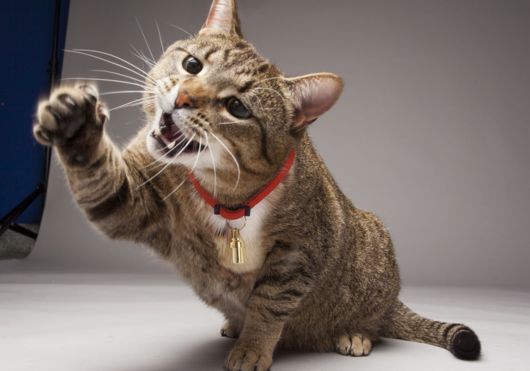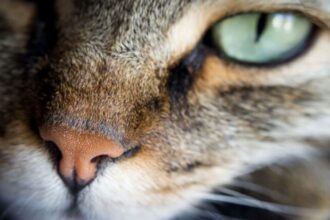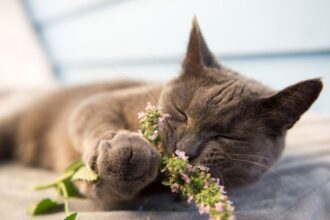Cats are mysterious and playful animals with interesting body features, especially claws. These claws are important tools cats use on toys, scratching posts, and occasionally on people. When not in use, cats can hide their claws inside their paws. Cats use muscles in their legs to pull on special ligaments to show their claws. Let’s learn how cats control their claws and how these natural tools work.
How Do Cat Claws Work?
A cat’s claws are keratin, the same material as human fingernails. This tough material helps keep their claws sharp.
Keratin, a protein found in animal nails, hair, horns, and hooves, grows in layers from living tissue called the quick. Cat claws are very similar to human nails, but small differences in their structure make them sharp and deadly.
The Anatomy of a Cat’s Claws
A cat’s claws are made of keratin layers that grow around a bump-shaped core at the tip of their toes. Unlike human nails, which grow flat, cat claws wrap around this core and form a sharp point.
Because of this growth pattern, cats can naturally shed the outer layers of their claws without harm. That’s why cat owners often find these shed claw pieces near scratching posts. This shedding helps keep their claws sharp and healthy. What makes cat claws even more special is how cats can pull them in and out using their muscles and tendons.
Muscles, Ligaments, and Tendons: The Quick Guide
A cat’s claw system is simpler than it seems. While we don’t need to know all the body parts involved, understanding the basics helps explain how cats control their claws.
Each claw is in a protective pocket at the tip of the toe. It is connected to the toe bone, which keeps it firm and steady. Two important tendons connect the claw to the bones, controlling whether it comes out or stays hidden.
Looking at a cat’s paw from the side, one tendon connects to the top of the claw, and another to the bottom. The cat uses two sets of muscles to move its claws, along with a stretchy band in each toe that lets them control their claws while walking or moving their paws. This gives cats full control over when to show or hide their claws.
How Do a Cat’s Claws Extend and Retract?
A muscle connects to the bottom of the bone that holds a cat’s claw. When this muscle tightens, it pulls the claw out. If this muscle doesn’t work properly, the claw can’t extend.
When the cat no longer needs its claws, the muscle relaxes, and the claw returns to its normal position. Cats’ claws naturally stay hidden until the cat flexes its muscles to extend them.
Trim your cat’s nails regularly to keep their paws healthy. Good-quality nail clippers with safety features make trimming easier and safer at home. Look for clippers with sharp blades, safety guards, and comfortable grips, and include a nail file for smooth results.
Do Cats Extend Their Claws on Purpose?
Cats control their claws both on purpose and by instinct. While they can choose when to show their claws, sometimes it happens automatically. For instance, cats naturally extend their claws when they’re stressed or when they’re happily kneading with their paws.
Some cats can’t fully hide their claws. This can happen if their toe bones are damaged and the connecting tissues don’t work properly. Also, if their nails grow too long, they’ll stick out from their paws even when retracted.
Where Do Cats Claws Go When They’re Retracted?
A cat’s claws are always there, even when pulled back. They don’t go inside the foot – instead, they hide in a fold of skin and fur. Special stretchy tissues pull the claws up and away from the ground, keeping them safe within the furry part of the cat’s paw.
Why Do Cats Have Claws? Do They Need To Retract?
The most obvious reason for cats having developed retractable claws is for hunting.
Hunting
Cats hunt quietly, sneaking up on their prey before attacking. Their claws can pull back inside their paws, letting them walk silently on their soft foot pads. This keeps their claws from making noise on the ground, so their prey won’t hear them coming.
When cats attack, their claws come out as they reach forward. The sharp claws can easily cut into the skin, helping cats grab and control their prey. Large wild cats need strong claws to hold onto big animals like buffalo that try to shake them off. House cats also need their claws to catch small, fast animals like mice.
Climbing
Cats use their claws to climb to high places, where they can watch for danger, food, or other cats in their area. Being up high helps them relax, and their claws help them grip tree bark while climbing.
Cat claws are made of keratin, which is strong but can break because they’re thin. Like when people break a nail, broken cat claws hurt and can bleed. Cats need their claws to hunt and defend themselves.
If a cat’s claws break, it might not be able to hunt or fight for its territory. Pet cats also need to pull their claws back so they don’t get caught on things around the house.
Advantages of Retractable Claws
Cats keep their claws tucked away to protect them from damage and wear. This also prevents the claws from cracking or breaking. When claws are pulled back, cats are less likely to hurt themselves, which could lead to dangerous infections.
Hidden claws don’t get caught in furniture, beds, or other surfaces as cats move around. This feature also helps cats catch prey more easily by allowing them to quickly grab and hold onto their target.
Disadvantages of Retractable Claws
Animals that can pull their claws in and out can’t dig well. Animals like badgers, moles, and groundhogs have fixed claws that help them dig holes and quickly escape from danger. Fixed claws are also better for running fast. For example, cheetahs use their always-out claws to grip the ground, helping them run faster to catch their food. Because their claws don’t pull in, cheetahs can run faster than other big cats.
Frequently Asked Questions (FAQs)
Which Cats Have Retractable Claws?
Most cats can pull their claws in and out, including house cats and wild cats like lions and tigers. The cheetah is different – it can’t retract its claws because its body is built for running fast.
Do Any Other Animals Have Retractable Claws?
Very few other animals can pull their claws in. Some animals like binturongs and civets can, and there’s one frog that can push its bones through its skin to make claws when it feels threatened. Most animals with claws can’t pull them in at all.
What Exactly Is Declawing?
Declawing a cat means removing the last bone and claw of each toe. It’s like cutting off the tips of a person’s fingers and toes. Because it is so harmful to cats, many countries have made it illegal.
Declawing is painful during healing and potentially for the rest of the cat’s life, causing physical pain and discomfort, balance changes, and psychological damage since they can’t climb, scratch, or mark territory.

Conclusion
Cat claws work amazingly. You can see how they work by softly pressing on your cat’s paw if your cat lets you. The claws will come out because of the ligaments moving, then slide back into the paw. Cats use their claws mainly for scratching or playing with toys. Next time you see your cat using their scratching post, you’ll know exactly how their claws are working!








